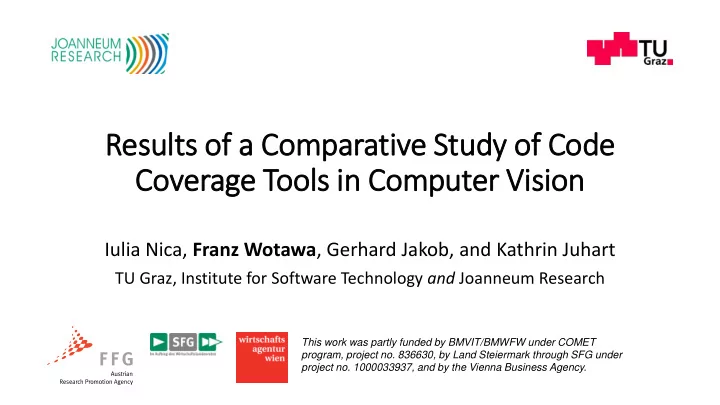

Results of f a C Comparative Study of f Code Coverage Tools in Computer Vision Iulia Nica, Franz Wotawa , Gerhard Jakob, and Kathrin Juhart TU Graz, Institute for Software Technology and Joanneum Research This work was partly funded by BMVIT/BMWFW under COMET program, project no. 836630, by Land Steiermark through SFG under project no. 1000033937, and by the Vienna Business Agency.
In Index • Motivation • Tools Selection • Case Study • Comparison of Coverage Results • Conclusions
Motivation I • The high quality of computer vision (CV) software has a great impact on the usability of the overall CV systems • Standardized quality assurance methods, metrics and tools can quickly improve the overall process • Initial goal : identify a coverage-based testing tool , capable to quickly find deficiencies in the available test suites.
Motivation II II • Highly varying results reported by different coverage tools for the example application Which might be the reasons for this variation? Which of the computed values better reflect the real quality of the code?
Tools Selection I • Target programming language: C/C++ • 9 candidate tools: Coverage Tool Access Line Function Branch More COVTOOL free Y gcov free Y Testwell CTC++ charge Y Y Y Y CoverageMeter v1.4 charge Y ? ? ? BullseyeCoverage charge Y Y Y C++ Coverage Validator charge Y Y Y Y Squish Coco charge Y Y Y Y C++ Test Coverage Tool charge ? Y ? OpenCPPCoverage free Y
Tools Se Selection II II
Case Study I • Dibgen - a collection of basic C++ libraries implemented by JOANNEUM RESEARCH (JR). • The libraries cover basic, mostly matrix based mathematical operations, color handling and evaluation, generic parameter storage, progress information handling, different types of basic file IO methods often used in CV, and value-to-string conversion (and back- conversion). • The libraries are implemented using template-heavy C++ code
Case Study II II • For the experiments we used the same unit test suites and the same configuration. • We have fully automated the tests running and coverage measurement process. • Execution time for the defined unit tests:
Comparison of f Coverage Results I • Overall DIBGEN Coverage Results C++ Coverage Validator Testwell CTC++ BullseyeCoverage Squish Coco BC% 31,27% 9% 40% 45,30% FC% 39,86% 8% 52% 51,95% How does each tool compute the coverage? I. Analyze the exact definitions for function and branch coverage II. Compare the instrumented files
Comparison of f Coverage Results II II • Function coverage (generally accepted definition): a function is covered if the function is entered. (Testwell CTC++, BullseyeCoverage, Squish Coco) • Function coverage (C++ Coverage Validator): "focuses on line coverage at the function level“. • Branch coverage: reports whether Boolean expressions tested in control structures evaluate to both true and false. (all the tools) + coverage of switch statement cases and unconditional control. (Testwell CTC++) + coverage of switch statement cases, exception handlers, and all points of entry and exit. (BullseyeCoverage)
Comparison of f Coverage Results III III • Coverage results per Library (Function Coverage) computed with all the four tools
Comparison of f Coverage Results IV IV 100,00% Coverage Validator 90,00% Testwell CTC++ 80,00% BullseyeCoverage 70,00% Squish Coco Function Coverage 60,00% 50,00% 40,00% 30,00% 20,00% 10,00% 0,00%
Comparison of f Coverage Results V 100,00% Coverage Validator 90,00% Testwell CTC++ BullseyeCoverage 80,00% Squish Coco 70,00% Branch Coverage 60,00% 50,00% 40,00% 30,00% 20,00% 10,00% 0,00%
Comparison of f Coverage Results VI VI • Testwell CTC++ instruments 3 additional cpp files, which contain only preprocessor directives and namespace declarations. • Another major discrepancy appears in case of two files ColorMapReader.cpp and ColorMapWriter.cpp .
Conclusions • There are three main reasons for the varying results: • some of the tools report header files either inside the code files they were included in or as own file entities, while others report them separately, • the definition of the used coverage metric also differs, • some of the tools seem not to consider all source files provided. • Due to the fast learning curve, intuitive user interface, and easy automation, we decided to further use C++ Coverage Validator .
Collaboration • How did you get incontact? • Joanneum Research contacted us • How did you collaborate? • Joint meetings for obtaining the needs and requirements • Providing a solution for the most challenging need • Discussing the solution with Joanneum Research • How long have you collaborated? • A little bit more than one year • What challenges/success factors did you experience? • Knowing the needs and requirements of the partner • Experience should fit needs and requirements • Open discussion culture • There is sometimes a gap between what academic partners can provide and industry is asking for.
Recommend
More recommend